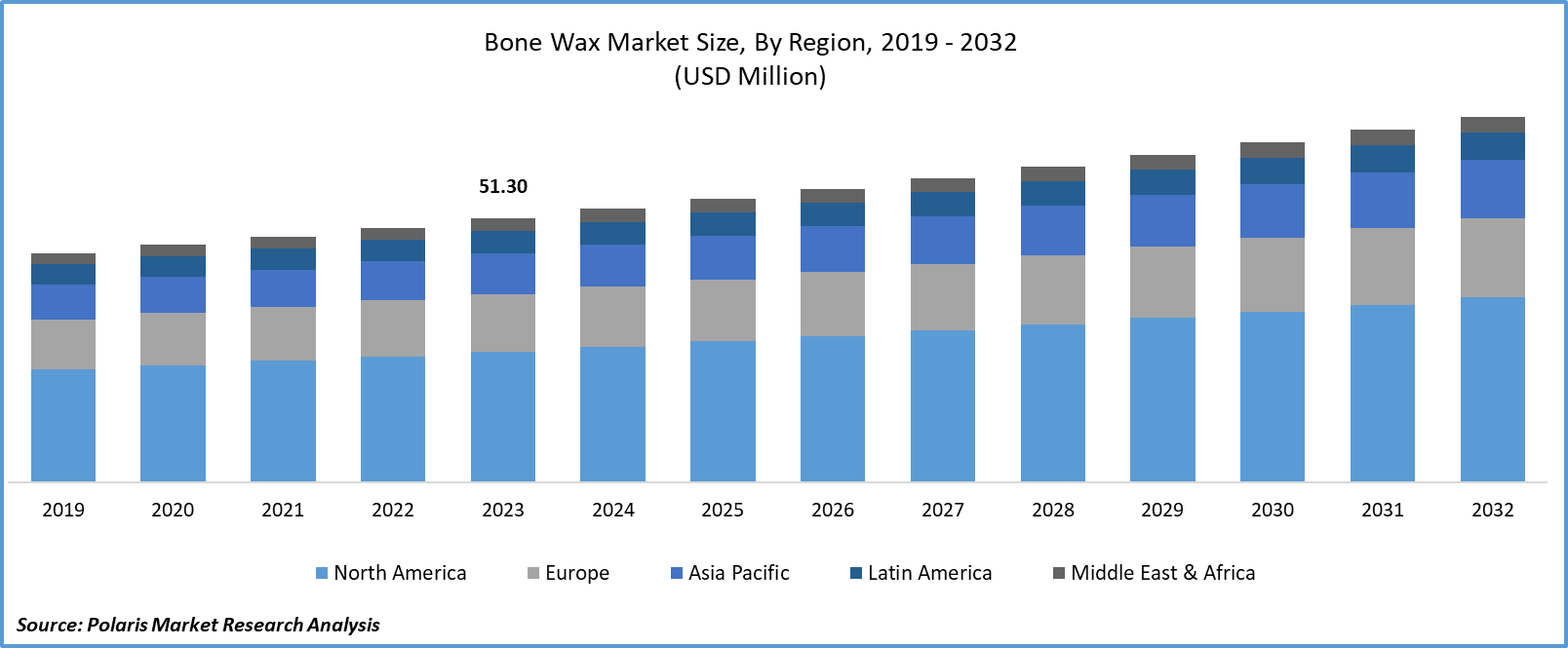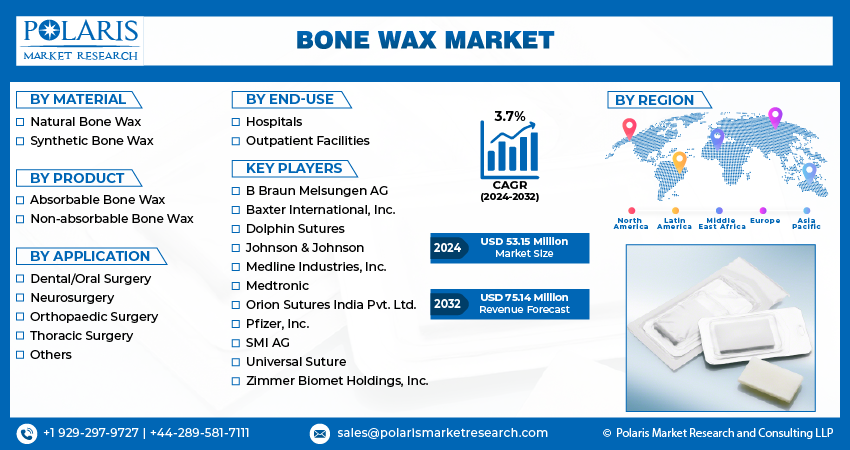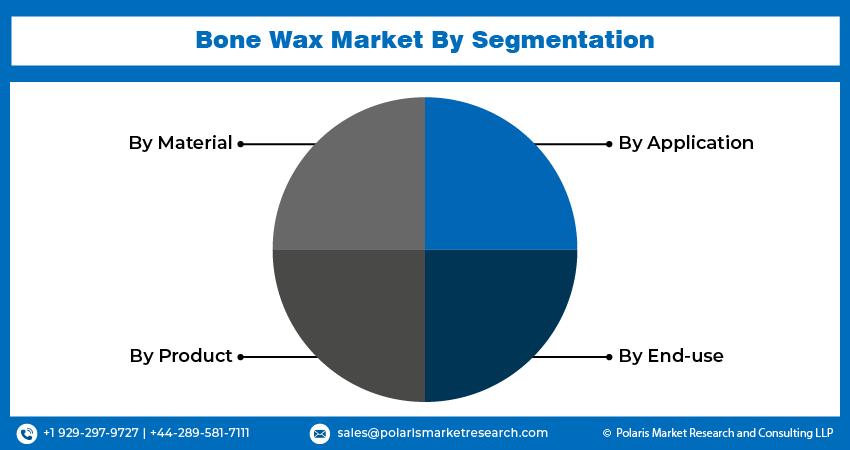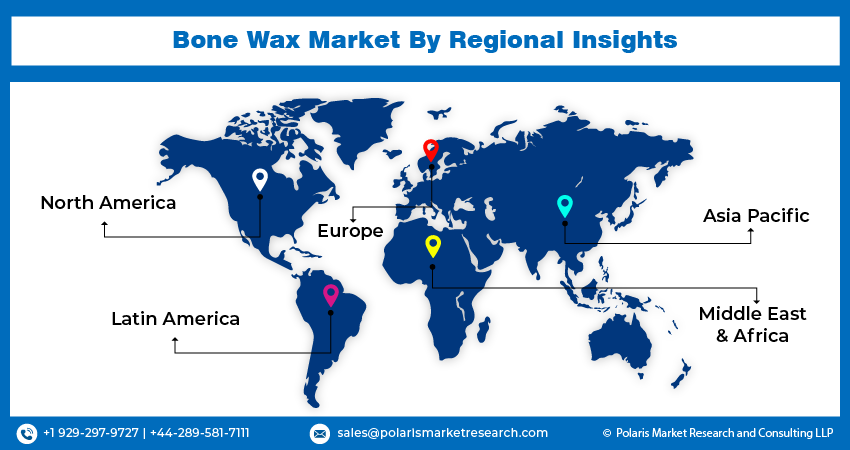
Bone Wax Market Share, Size, Trends, Industry Analysis Report, By Material (Natural Bone Wax, And Synthetic Bone Wax); By Product; By Application; By End-Use; By Region.; Segment Forecast, 2024- 2032
- Published Date:Mar-2024
- Pages: 117
- Format: PDF
- Report ID: PM4767
- Base Year: 2023
- Historical Data: 2019-2022
Report Outlook
Global bone wax market size was valued at USD 51.30 million in 2023. The market is anticipated to grow from USD 53.15 million in 2024 to USD 71.14 million by 2032, exhibiting a CAGR of 3.7% % during the forecast period.
Industry Trend
Bone wax serves as a critical component in surgical procedures by effectively stemming bleeding from bone surfaces. Comprising a blend of beeswax and Vaseline, typically in a ratio of 70% to 30%, this sterile material acts as a mechanical barrier to staunch bleeding, thereby facilitating local hemostasis within bones. Its utility extends across various surgical disciplines, including thoracic surgery, neurosurgery, Orthopedics, and traumatology, as well as dental, oral, and jaw surgery, where it is instrumental in achieving mechanical hemostasis within bones. The demographic shift towards an aging population, coupled with an uptick in surgical interventions related to Orthopedic disorders and accidental fractures, is expected to fuel market expansion. Furthermore, the increasing adoption of absorbable bone wax products, particularly in arthroplasty procedures, contributes to this growth trajectory.
Sports and recreational activities also play a role, contributing to the rise in Orthopedic injuries and surgical interventions. This trend, alongside the escalating prevalence of Orthopedic diseases and accidental fractures, further propels the demand for bone wax within the medical landscape. As a result, the bone wax market share is estimated to grow during the forecast period.

To Understand More About this Research: Request a Free Sample Report
However, despite the promising outlook, some areas warrant further investigation. Research indicates a need for more comprehensive studies to ascertain the efficacy of bone wax, particularly in patients with coagulation disorders. Consequently, ongoing research and development efforts aimed at evaluating the effectiveness of bone wax in arthroplasty surgeries are anticipated to stimulate bone wax market size expansion during the forecast period.
The company has initiated a substantial innovation initiative, representing a decisive move towards enhancing its operational processes. Through the adoption of a comprehensive strategy aimed at expanding its market presence, reaching out to new demographics, and promoting sustainable growth within a dynamic business environment, the company is positioned for success. By harnessing the synergies of investment, technology, innovation, and strategic planning, it is well-prepared to maintain its competitive advantage and establish itself as a leader in its industry. As a result, significant growth is expected in the bone wax market share during the forecast period.
There is growing interest in absorbable bone wax formulations that eliminate the need for subsequent removal, reducing surgical time and potential complications. Research and development efforts focused on creating absorbable bone wax products with optimal hemostatic properties could capture a significant opportunity in the market. Hence, the bone wax market share is estimated to increase during the forecast period.
Key Takeaway
- North America dominated the largest market and contributed to more than 36% of share in 2023.
- Asia Pacific market is expected to witness the fastest growing CAGR during the forecast period.
- By Material category, natural bone wax segment accounted for the largest market share in 2023.
- By Application category, the Orthopaedic surgery segment is projected to grow at fastest CAGR during the projected period.
What are the Market Drivers Driving the Demand for the Bone Wax Market?
Rising Surgical Interventions is Projected to Spur Product Demand
The increasing frequency of surgical procedures, especially within specialized fields like Orthopedics, neurosurgery, and traumatology, significantly impacts the demand for bone wax. This surge in surgical interventions can be attributed to several factors. Advancements in medical technology and surgical techniques have made procedures more accessible, efficient, and safer. As a result, more patients are opting for surgical solutions to address various medical conditions, including bone-related issues such as fractures, degenerative diseases, and traumatic injuries. With a broader array of surgical options available, the demand for hemostatic agents like bone wax rises concomitantly.
Moreover, within Orthopedics, neurosurgery, and traumatology, where bone wax is frequently utilized, there has been a notable increase in the complexity and intricacy of procedures. Surgeons are now able to perform intricate surgeries with greater precision and efficacy, enabling them to address a wider range of conditions and pathologies. However, with this sophistication comes an increased risk of bleeding complications, necessitating reliable hemostatic agents like bone wax to ensure optimal patient outcomes. Hence, the bone wax market share is increasing as the demand for bone wax is rising significantly.
Additionally, demographic trends, such as the aging population, contribute to the rising demand for surgical interventions in fields like Orthopedics. As individuals age, they become more prone to musculoskeletal disorders, fractures, and degenerative conditions, which often require surgical management. Consequently, the growing prevalence of these conditions fuels the need for bone wax as a crucial tool in achieving hemostasis during surgical procedures, which will raise the bone wax market share in the upcoming years.
Which Factor is Restraining the Demand for Bone Wax?
The Ongoing Research and Development Aimed at Finding Alternative Hemostatic Agents or Methods is Likely to Impede Market Growth
While bone wax is widely used and effective in achieving hemostasis during surgical procedures, the medical community is always driven to improve patient outcomes, minimize risks, and enhance surgical techniques. As a result, researchers and medical professionals are continuously exploring alternative options such as synthetic hemostatic agents, sealants, and advanced surgical techniques that may offer advantages over traditional methods like bone wax. These alternatives may tout benefits such as faster absorption, reduced inflammation, better tissue compatibility, and lower risk of complications.
Additionally, there may be concerns or limitations associated with the use of bone wax in certain patient populations or surgical contexts. For example, there could be cases where the presence of bone wax interferes with subsequent imaging studies or diagnostic procedures. Furthermore, some patients may have allergies or sensitivities to the components of bone wax, leading surgeons to seek alternative hemostatic solutions.
Moreover, cost considerations could also influence the demand for bone wax. While bone wax is generally considered a cost-effective option for achieving hemostasis, healthcare institutions may explore cheaper alternatives or negotiate pricing with suppliers to optimize budget allocation.

Report Segmentation
The market is primarily segmented based on material, product, application, end-use, and region.
|
By Material |
By Product |
By Application |
By End-use |
By Region |
|
|
|
|
|
To Understand the Scope of this Report: Speak to Analyst
Category Wise Insights
By Material Insights
Based on the material analysis, the market is segmented into natural bone wax and synthetic bone wax. Natural bone wax, derived from beeswax, held the largest market share in 2023. It has been utilized in surgical procedures for many years and is well-established in medical practice. Surgeons and healthcare providers may be highly familiar with natural bone wax, leading to its widespread use and adoption.
Natural bone wax is known for its hemostatic properties, effectively controlling bleeding from bone surfaces during surgical procedures. Its perceived effectiveness in achieving hemostasis may contribute to its continued preference among surgeons and healthcare professionals. This trend towards advanced technology adoption is a key driver propelling the overall growth of the market.
By Application Insights
Based on application analysis, the market has been segmented on the basis of dental/oral surgery, neurosurgery, orthopedic surgery, thoracic surgery, and others. The orthopedic surgery segment is projected to grow at the fastest CAGR during the forecast period. As the global population continues to age, there is a corresponding increase in the prevalence of Orthopedic conditions such as osteoarthritis, osteoporosis, and fractures. Older individuals are more likely to require Orthopedic interventions, including joint replacements, fracture repairs, and spinal surgeries, driving the demand for Orthopedic surgeries.
Moreover, advancements in orthopedic surgical techniques, including minimally invasive procedures and robotic-assisted surgery, have improved patient outcomes, reduced recovery times, and expanded the range of treatable conditions. These innovations attract more patients to undergo Orthopedic procedures, fueling the growth of the segment.

Regional Insights
North America
North America region accounted for the largest market share in 2023. North America boasts highly developed healthcare infrastructure, including advanced surgical facilities, well-equipped hospitals, and specialized medical centers. This infrastructure supports the widespread adoption of surgical procedures, including those requiring bone wax, contributing to the region's dominance in the market. The region experiences a high prevalence of Orthopedic disorders, such as osteoarthritis, fractures, and sports injuries, leading to a substantial number of orthopedic surgeries. Orthopedic procedures frequently involve the use of bone wax to control bleeding, driving demand for bone wax products in North America.
Asia Pacific
Asia Pacific is expected to grow at the fastest CAGR during the forecast period. The Asia-Pacific region is experiencing significant growth in healthcare infrastructure, with investments in hospitals, clinics, and surgical facilities. This expansion enhances access to surgical procedures, including orthopedic surgeries that frequently require the use of bone wax. As economic development progresses in countries across Asia-Pacific, there is a corresponding increase in healthcare expenditure and demand for medical services. Rising disposable incomes, urbanization, and improved access to healthcare contribute to a surge in surgical volumes, driving demand for bone wax products.

Competitive Landscape
The competitive landscape of the bone wax market refers to the overall structure and dynamics of the industry, including the major players, their market shares, strategies, and competitive factors influencing the market, in the context of bone wax, which is a medical device used in surgical procedures to control bleeding from bone surfaces. Market share varies among competitors and may be influenced by factors such as product quality, brand reputation, pricing strategy, distribution network, and geographic presence. Companies with innovative products or strong customer relationships may have a larger share of the market.
Some of the major players operating in the global market include:
- B Braun Melsungen AG
- Baxter International, Inc.
- Dolphin Sutures
- Johnson & Johnson
- Medline Industries, Inc.
- Medtronic
- Orion Sutures India Pvt. Ltd.
- Pfizer, Inc.
- SMI AG
- Universal Suture
- Zimmer Biomet Holdings, Inc.
Recent Developments
- In February 2019, Terumo Cardiovascular Group and Hemostasis, LLC., revealed a three-year exclusive distribution agreement aimed at introducing BoneSeal bone hemostat to theUS cardiac surgery market. For years, cardiac surgeons have endeavored to address bleeding from sternotomies by employing a variety of hemostats, including bone wax, putties, powders, and gelatin.
Report Coverage
The Bone Wax Market report emphasizes on key regions across the globe to provide better understanding of the product to the users. Also, the report provides market insights into recent developments, trends and analyzes the technologies that are gaining traction around the globe. Furthermore, the report covers in-depth qualitative analysis pertaining to various paradigm shifts associated with the transformation of these solutions.
The report provides detailed analysis of the market while focusing on various key aspects such as competitive analysis, material, product, application, end-use, and their futuristic growth opportunities.
Bone Wax Market Report Scope
|
Report Attributes |
Details |
|
Market size value in 2024 |
USD 53.15 million |
|
Revenue forecast in 2032 |
USD 71.14 million |
|
CAGR |
3.7% from 2024 – 2032 |
|
Base year |
2023 |
|
Historical data |
2019 – 2022 |
|
Forecast period |
2024 – 2032 |
|
Quantitative units |
Revenue in USD million and CAGR from 2024 to 2032 |
|
Segments covered |
By Material, By Product, By Application, By End Use and By Region |
|
Regional scope |
North America, Europe, Asia Pacific, Latin America, Middle East & Africa |
|
Customization |
Report customization as per your requirements with respect to countries, region, and segmentation. |
FAQ's
key companies in Bone Wax Market are B Braun Melsungen AG, Baxter International, Inc., Dolphin Sutures, Johnson & Johnson, Medline Industries, Inc
Bone wax market exhibiting a CAGR of 3.7% % during the forecast period.
The Bone Wax Market report covering key segments are material, product, application, end-use and region.
key driving factors in Bone Wax Market are rising Surgical Interventions is projected to spur product demand
The global bone wax market size is expected to reach USD 71.14 million by 2032
